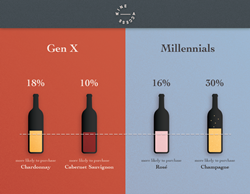
29 Aug, 2019
Wine Industry survey finds Baby Boomers better targets than Millennials
SAN FRANCISCO, 28 AUGUST 2019, PRWEB — Wine Access, an online direct-to-consumer wine retailer, announced today the findings of a recent internal study of sales data that shows Generation X holds greater immediate purchasing potential than Millennials, despite greater industry focus on wooing the younger generation. The data, which spans 2017 to 2019, supports recent media reports that suggest Gen X (currently ages 37-52) is a key demographic that should not continue to be overlooked when it comes to wine marketing.

Gen X is more likely to purchase Chardonnay and Cabernet Sauvignon than Millennials. Millennials are more likely to purchase Rosé and Champagne than Gen X. Image courtesy of Wine Access.
According to Wine Access, the average Gen X customer order, in dollars, was 13% greater than all other demographics between 2017 and 2019, beating out both Boomers (currently ages 53-71) and Millennials (currently ages 21-36). While Wine Access has seen major growth in Millennial sales over the last three years, Gen Xers spent nearly 6% more per order than their younger peers in 2019. Boomers continue to outperform Gen X in average number of bottles per order, but spend less on average.
“Boomers have historically driven our business, but Gen Xers are becoming the big buyers,” notes Joe Fisch, CEO of Wine Access. “While we have seen significant growth among our Millennial buyers in recent years, our sales show that Gen X holds the most immediate potential. Like Millennials, Gen Xers seek authenticity and intimate experiences when purchasing wine, but Gen Xers have greater financial resources at their disposal to pursue them. That’s why we invest in telling the story of every bottle of wine we sell through text, infographics, and video, developed by our team of wine experts.”
Wine Access has over half a million members, secured primarily without paid advertising. Approximately 25% of all new buyers are referred through forwarded email offers, which are loaded with content, sharing the wine’s story in 500 to 1,000 words written by an expert. “It’s our dynamic content and close relationships with the world’s best producers that attract our buyers, plus our ability to offer wines that aren’t available elsewhere,” commented Vanessa Conlin, Head of Wine. “By examining purchasing patterns of each demographic, we can understand reactions to our content and see valuable consumer trends. For instance, Gen Xers are more likely to make purchases based on their established tastes, while Millennials tend to buy in correlation with industry trends.”
Following the data, compared to all other demographics, Gen X is 13% more likely to purchase Cabernet Sauvignon, 13% more likely to purchase Left Bank Bordeaux, and 12% more likely to purchase Right Bank Bordeaux. Meanwhile, Millennials are 46% more likely to purchase Champagne, 29% more likely to purchase Tempranillo, and 24% more likely to purchase Rosé than other demographics.
These patterns in Millennial purchases are aligned with domestic consumption trends: the sparkling wine segment (domestic and international) grew almost 6% in 2018 and consumption grew by 56% in the last decade (Beverage Wholesaler, 2019). The Rosé category grew by 48% in 2018 alone to $4.6 million in sales (Beverage Industry Enthusiast, 2019).
Although Millennials are buying based on trends more than other demographics, they do continue to purchase more traditionally sought-after varietals from Wine Access. For instance, Cabernet Sauvignon accounted for nearly 27% of all Millennial purchases, trailing Gen X by only 3%. Millennials also buy historically popular categories such as Sauvignon Blanc, Sangiovese, and Bordeaux at a similar rate to Gen X, and even out-buy Gen X in some esoteric categories, such as Brunello di Montalcino and Châteauneuf-du-Pape. That being said, both generations also explore beyond these categories, as Wine Access offers a wide selection that includes lesser-known varieties and regions.
Wine Access will continue to connect with new and current consumers by offering engaging storytelling, exclusive access to some of the world’s best wines, and elevated customer service. They believe these elements are key to engaging and attracting new consumers in the wine industry, across demographics.
For more information, click here: https://www.wineaccess.com/



Liked this article? Share it!